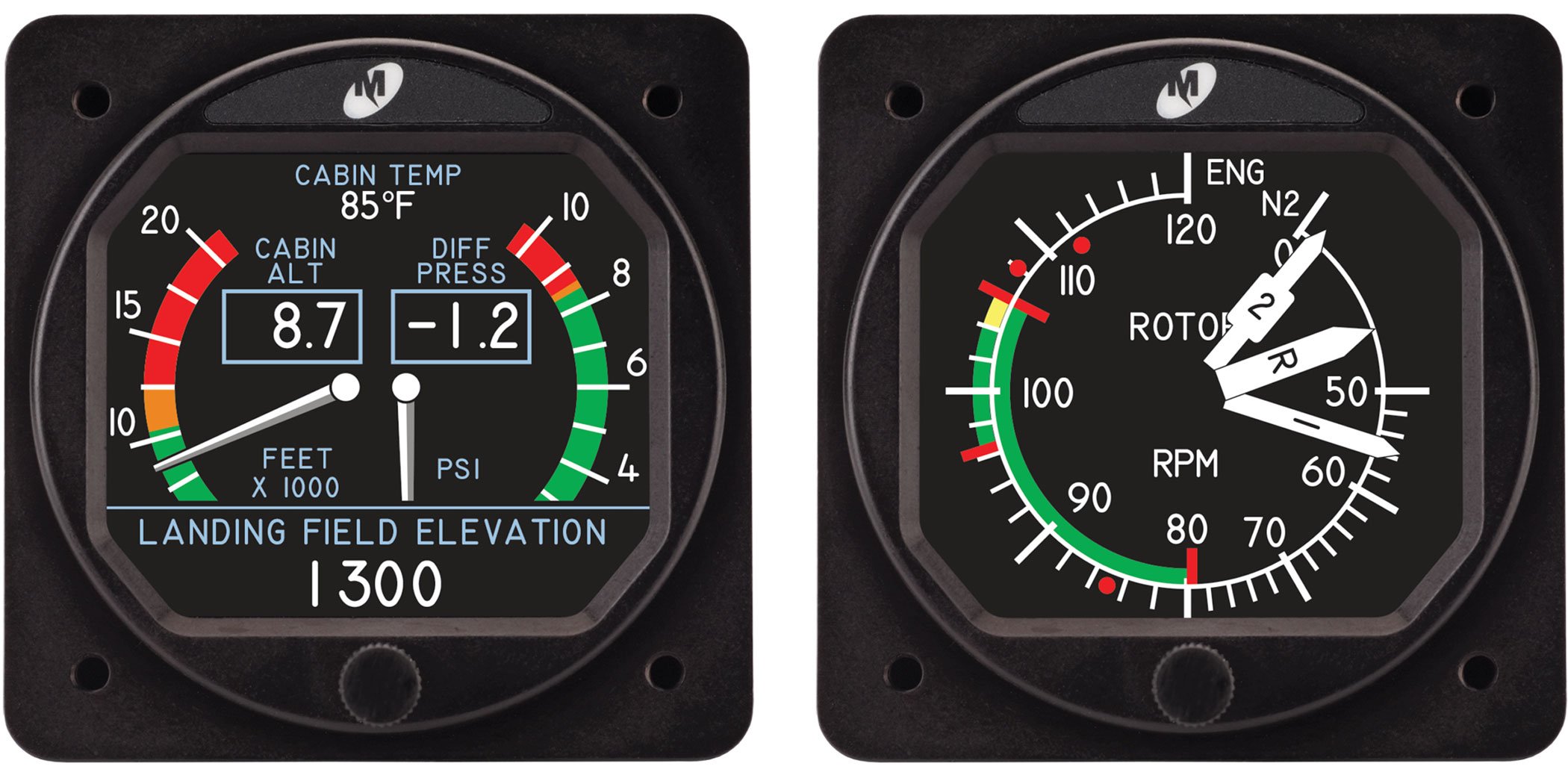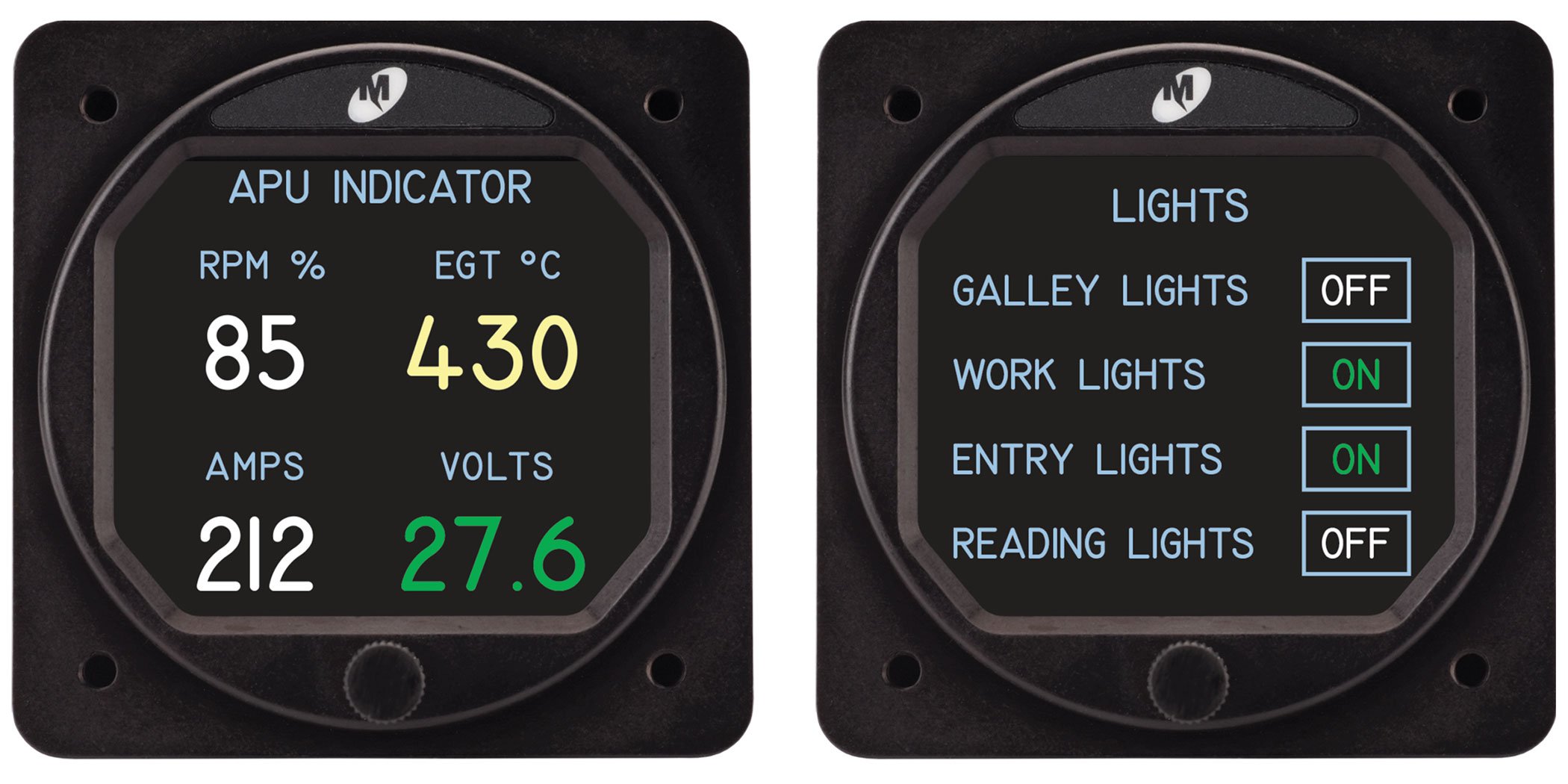Mid-Continent Instruments and Avionics has introduced the Flex MD23 Custom Function Display, a new series of forward-fit and retrofit displays that can be customized to fit hundreds of applications.
The Flex display is a blank slate on which avionics and systems engineers and designers can create almost any kind of instrumentation display and control output. According to Mid-Continent, Flex is “a custom display, controller, and data converter, all-in-one.”
What is unique about Flex is that Mid-Continent has already obtained FAA certification for the hardware and the software that runs inside the instrument. All that remains is for the customer to work with Mid-Continent on the design of what shows up on the Flex’s display and how it interacts with the aircraft, and the result is a much quicker method of adding display functionality and system control into many aircraft types.
Flex comes in two basic hardware platforms, one with pitot-static inputs and one without. The display fits in a standard 2.25-inch instrument panel hole and features daylight-readable, high-definition graphics with a single push-and-turn control knob for the user interface. Hardware certification includes FAA Technical Standard Order (TSO) C113b, C2d, C10c, and C106, and RTCA environmental qualification DO-160G. The software is certified to DO-178C, Design Assurance Level A. Flex can receive and display Arinc 429, analog, discrete, frequency, temperature, and absolute and differential pressure data.

One way to understand what Flex offers is to consider an aircraft that is being upgraded with a lithium-ion battery, for example, the True Blue Power TB40, which requires an indicator in the flight deck. The aircraft could be older and without glass displays or the existing displays can’t be modified by the original equipment manufacturer (OEM) to show the battery information without a significant amount of software redesign and certification work.
“We’ve run into situations where existing displays and systems—the design and control methodology—they can’t be changed,” said Todd Winter, Mid-Continent president and CEO. “Either the OEM says ‘we can’t change it,’ or they say ‘we might be interested but the people who provide our primary flight displays and engine instruments, if we go to them and ask for this, it’s going to take forever and it’s going to cost a fortune,’ and that’s understandable.
“That’s not the exact reason why we developed this product but it’s a good example of why it’s needed,” he explained. “This is a much more cost-effective way for somebody to add functionality that they feel is important or that is required to certify something new or slightly different on an airframe.”

The point is not for Flex to be able to change from one instrument to another in an end user’s instrument panel, explained v-p of engineering Brett Williams. Rather, an avionics or MRO shop or OEM can make Flex into whatever type of display and control device is needed, all in a compact and easily retrofittable package. Instead of designing an instrument to do one thing, for example, to be an attitude indicator, then going through all the trouble to certify that specific instrument, a Flex customer can design the instrument and all of its functionality and get it ready to install in a much shorter period of time. This is because the underlying hardware and software of Flex is already certified. All that needs to be approved is the final configuration and installation.
“Flex is a two-part solution: the base hardware and software are fixed, while the configuration and digital display are flexible,” he explained. “Each unit is customized through unique Custom Instrument Definition (CID) settings, specific to the application.”
The possible applications for Flex are almost endless, and customers could choose a Flex MD23 instrument to perform one function or combination of functions. It could be a radar altimeter display, for example, or cabin pressure indication and controller, an autopilot controller, fuel management display, airspeed or angle-of-attack indicator, air data computer, engine data indicator, or serve many other functions. A creative customer might want to design a clock combined with a density altitude indicator or a landing gear indicator optimized for amphibious operations.
“We’ve certified all the different possible data inputs,” Williams said, “and we’ve proven the Flex operating system can handle and manipulate those. It doesn’t matter what you throw at us as long as it uses the type of data that can be accepted. Then we can manipulate them any way we want. It has this inherent flexibility. We build on the base hardware and software certification.”
Once a customer chooses a Flex solution, then it’s up to the customer to specify what the display will look like and do. And this may require a supplemental type certificate (STC) for installation in an aircraft.
“The FAA has a multi-layer approval and certification process,” Williams explained. “We’ve been able to certify the design. But to get installation, you’ll need an STC or field approval. It’s still a secondary layer of certification, to say it fits the intended use and is appropriate and applicable.”
Mid-Continent will help customers with that step. “It’s a partnership of certification,” he said. “The design certification that we’ve achieved and local authority approval.”
Mid-Continent CEO Winter explained that one of the reasons for developing Flex is that there are fewer suppliers making dedicated, specialized indicators. But there is demand for these types of products. “We have companies and operators that need a solution,” he said. “We can’t get old components, and it’s just not economical to go another route. This is what we hope will be an ideal bridge between all those hundreds of thousands of indicators in the aftermarket but also specialty needs going forward for OEMs that need to display something.”
“This is the ultimate gauge,” said Williams, “with the ability to shortcut the long and expensive process of custom product development. That is the goal behind the genesis of Flex. We’ve found a way to get something into customers’ hands in weeks or just a few months instead of years, and save them thousands, if not hundreds of thousands of dollars.”







